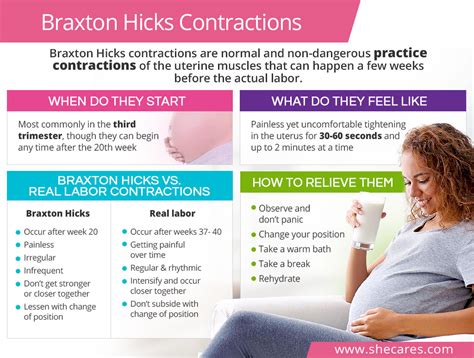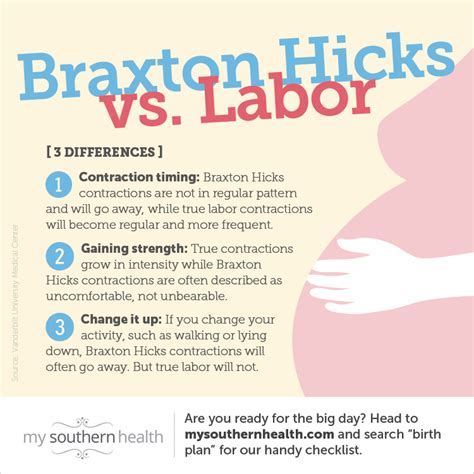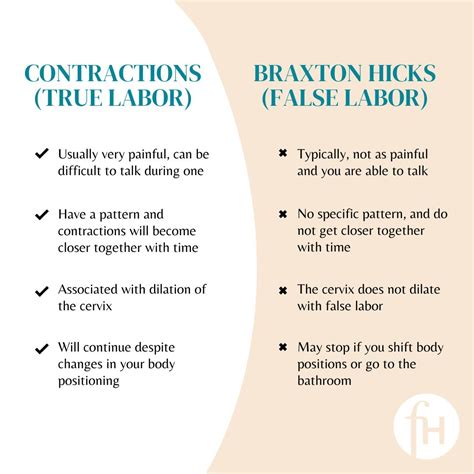Intro
Discover when Braxton Hicks contractions begin, a precursor to labor, and learn about false labor pains, pregnancy symptoms, and preterm labor signs, to prepare for a healthy birth experience.
Braxton Hicks contractions are a normal part of pregnancy, and they can start as early as the second trimester. These contractions are often referred to as "practice contractions" because they help prepare the uterus for labor. However, the exact timing of when Braxton Hicks begin can vary from woman to woman. Some women may experience them earlier or later in their pregnancy than others.
For most women, Braxton Hicks contractions start between 16 and 20 weeks of gestation. During this time, the uterus is still relatively small, and the contractions may feel like mild menstrual cramps or a tightening sensation in the abdomen. As the pregnancy progresses, the contractions can become more intense and frequent, but they are usually not as strong as real labor contractions.
It's essential to understand that Braxton Hicks contractions are a normal part of pregnancy, and they do not necessarily mean that labor is imminent. However, they can be uncomfortable and may cause anxiety, especially for first-time mothers. Knowing what to expect and how to manage these contractions can help alleviate concerns and make the pregnancy journey more comfortable.
What are Braxton Hicks Contractions?

The primary difference between Braxton Hicks contractions and real labor contractions is their intensity and frequency. Braxton Hicks contractions are usually mild and irregular, while labor contractions are more intense and regular. Additionally, Braxton Hicks contractions do not lead to cervical dilation or effacement, which are hallmarks of real labor.
Characteristics of Braxton Hicks Contractions
Some key characteristics of Braxton Hicks contractions include: * Mild to moderate discomfort or pain * Intermittent and irregular contractions * Contractions that are usually less than 30 seconds long * Contractions that do not increase in intensity or frequency over time * No cervical dilation or effacement * May be triggered by fetal movement, a full bladder, or dehydrationHow to Manage Braxton Hicks Contractions

When to Seek Medical Attention
While Braxton Hicks contractions are a normal part of pregnancy, there are times when it's essential to seek medical attention. Some scenarios include: * Contractions that are severe or persistent * Contractions that are accompanied by vaginal bleeding or discharge * Contractions that are regular and intense, lasting more than 30 seconds * A fever over 100.4°F (38°C) * Severe abdominal pain or tenderness * Fetal movement that is decreased or absentDistinguishing Between Braxton Hicks and Real Labor

Preparing for Real Labor
While Braxton Hicks contractions can be uncomfortable, they can also help prepare the uterus for real labor. Some ways to prepare for real labor include: * Taking childbirth education classes * Practicing relaxation techniques, such as deep breathing or meditation * Creating a birth plan * Staying physically active and healthy * Building a support network of family and friendsConclusion and Next Steps

We invite you to share your experiences with Braxton Hicks contractions in the comments below. Have you experienced Braxton Hicks contractions during your pregnancy? How did you manage them? Share your tips and advice with other expectant mothers.
What are Braxton Hicks contractions?
+Braxton Hicks contractions are intermittent, painless, or mildly uncomfortable contractions that occur during pregnancy. They are caused by the uterus contracting and relaxing, which helps prepare it for labor.
When do Braxton Hicks contractions start?
+Braxton Hicks contractions can start as early as the second trimester, usually between 16 and 20 weeks of gestation.
How can I manage Braxton Hicks contractions?
+Some strategies to manage Braxton Hicks contractions include changing positions, drinking water, practicing relaxation techniques, applying heat or cold, and engaging in physical activity.
What is the difference between Braxton Hicks and real labor?
+The primary difference between Braxton Hicks contractions and real labor contractions is their intensity and frequency. Real labor contractions are more intense and regular, and they lead to cervical dilation and effacement.
When should I seek medical attention for Braxton Hicks contractions?
+Seek medical attention if you experience contractions that are severe or persistent, accompanied by vaginal bleeding or discharge, or if you have a fever over 100.4°F (38°C).
